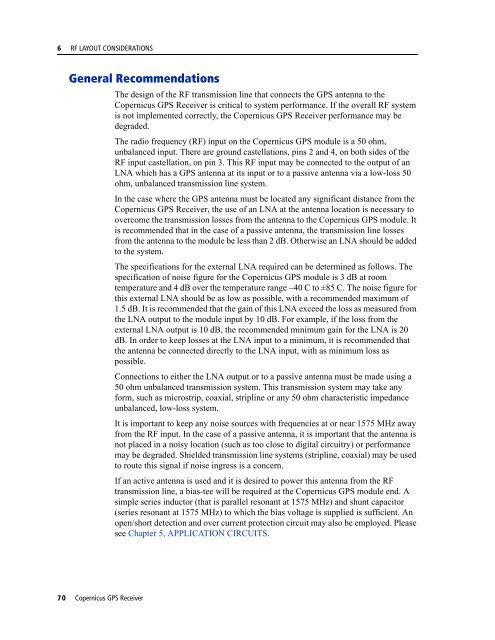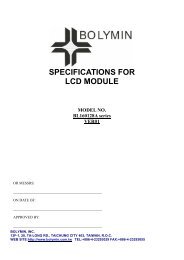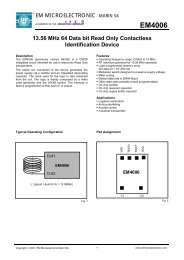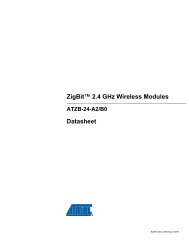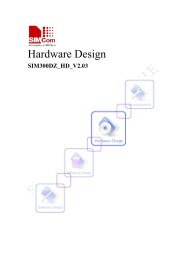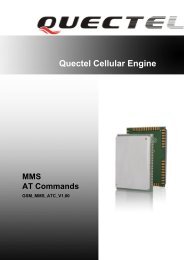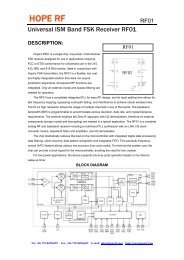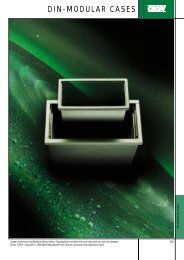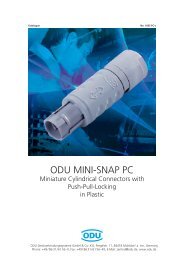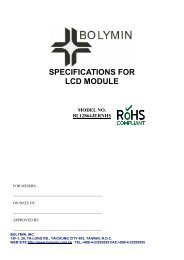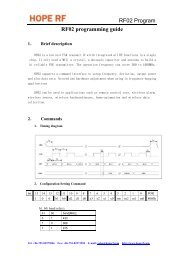REFERENCE MANUAL - FTP Directory Listing - Trimble
REFERENCE MANUAL - FTP Directory Listing - Trimble
REFERENCE MANUAL - FTP Directory Listing - Trimble
Create successful ePaper yourself
Turn your PDF publications into a flip-book with our unique Google optimized e-Paper software.
6 RF LAYOUT CONSIDERATIONS<br />
General Recommendations<br />
The design of the RF transmission line that connects the GPS antenna to the<br />
Copernicus GPS Receiver is critical to system performance. If the overall RF system<br />
is not implemented correctly, the Copernicus GPS Receiver performance may be<br />
degraded.<br />
The radio frequency (RF) input on the Copernicus GPS module is a 50 ohm,<br />
unbalanced input. There are ground castellations, pins 2 and 4, on both sides of the<br />
RF input castellation, on pin 3. This RF input may be connected to the output of an<br />
LNA which has a GPS antenna at its input or to a passive antenna via a low-loss 50<br />
ohm, unbalanced transmission line system.<br />
In the case where the GPS antenna must be located any significant distance from the<br />
Copernicus GPS Receiver, the use of an LNA at the antenna location is necessary to<br />
overcome the transmission losses from the antenna to the Copernicus GPS module. It<br />
is recommended that in the case of a passive antenna, the transmission line losses<br />
from the antenna to the module be less than 2 dB. Otherwise an LNA should be added<br />
to the system.<br />
The specifications for the external LNA required can be determined as follows. The<br />
specification of noise figure for the Copernicus GPS module is 3 dB at room<br />
temperature and 4 dB over the temperature range −40 C to ±85 C. The noise figure for<br />
this external LNA should be as low as possible, with a recommended maximum of<br />
1.5 dB. It is recommended that the gain of this LNA exceed the loss as measured from<br />
the LNA output to the module input by 10 dB. For example, if the loss from the<br />
external LNA output is 10 dB, the recommended minimum gain for the LNA is 20<br />
dB. In order to keep losses at the LNA input to a minimum, it is recommended that<br />
the antenna be connected directly to the LNA input, with as minimum loss as<br />
possible.<br />
Connections to either the LNA output or to a passive antenna must be made using a<br />
50 ohm unbalanced transmission system. This transmission system may take any<br />
form, such as microstrip, coaxial, stripline or any 50 ohm characteristic impedance<br />
unbalanced, low-loss system.<br />
It is important to keep any noise sources with frequencies at or near 1575 MHz away<br />
from the RF input. In the case of a passive antenna, it is important that the antenna is<br />
not placed in a noisy location (such as too close to digital circuitry) or performance<br />
may be degraded. Shielded transmission line systems (stripline, coaxial) may be used<br />
to route this signal if noise ingress is a concern.<br />
If an active antenna is used and it is desired to power this antenna from the RF<br />
transmission line, a bias-tee will be required at the Copernicus GPS module end. A<br />
simple series inductor (that is parallel resonant at 1575 MHz) and shunt capacitor<br />
(series resonant at 1575 MHz) to which the bias voltage is supplied is sufficient. An<br />
open/short detection and over current protection circuit may also be employed. Please<br />
see Chapter 5, APPLICATION CIRCUITS.<br />
70 Copernicus GPS Receiver


